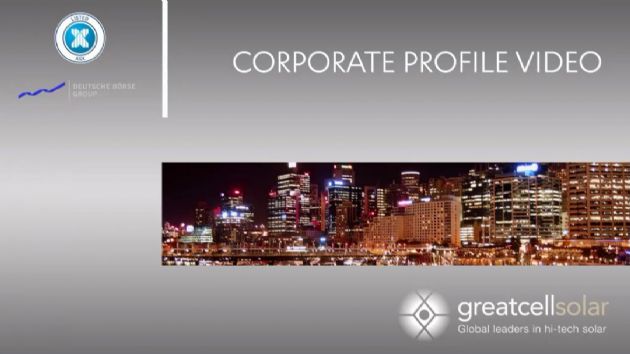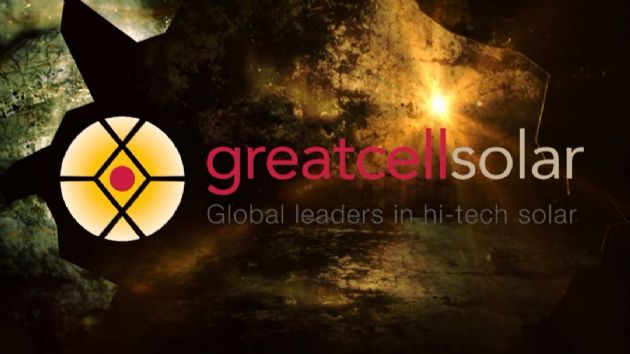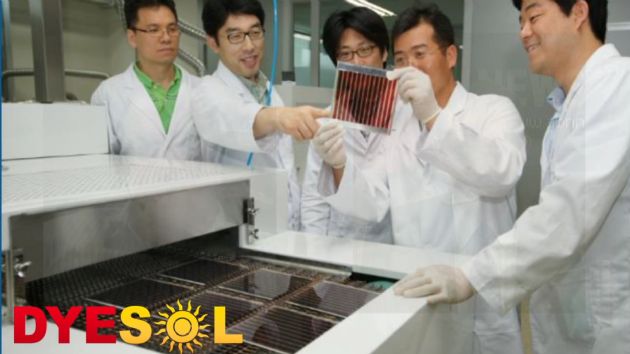 Annual Report to Shareholders
Annual Report to Shareholders
Canberra, Aug 28, 2015 AEST (ABN Newswire) - FY2015 was a very positive year for Dyesol Ltd ( ASX:DYE) with significant progress on the achievement of all formal technical milestones as the Company implements plans for scale-up and commercialisation. Perovskite Solar Cells (PSC) attracted enormous attention as a potentially disruptive and revolutionary technology and Dyesol continued to push the boundaries for higher conversion efficiency, lower cost and demonstrated stability.
ASX:DYE) with significant progress on the achievement of all formal technical milestones as the Company implements plans for scale-up and commercialisation. Perovskite Solar Cells (PSC) attracted enormous attention as a potentially disruptive and revolutionary technology and Dyesol continued to push the boundaries for higher conversion efficiency, lower cost and demonstrated stability.
In a macro context, the environment for renewables and, in particular, solar also improved during the year as enlightened governments around the world increasingly responded to the challenge of climate-change. Leadership from China and the U.S.A. will be an important catalyst for wider acceptance of these goals. Australia, unfortunately, continues to be divided on political lines in its acceptance and response to climatechange.
Industry and Market Conditions
The dust has now settled after the sudden demise of the solar industry from 2011 through to 2013 and growth in installations is strong.
In 2014, cumulative photovoltaic capacity increased by 40.1 GW or 28% and reached at least 178 GW by the end of the year, sufficient to supply 1 percent of the world's total electricity consumption of currently 18,400 TWh. Although this represents a new all-time record in the history of global PV deployment, overall expectations had been higher as module shipments amounted to 44- 46 GW and suggested higher overall installations. Annual installation for 2014 expanded slightly by 5% when compared to worldwide installation of 38.3 GW in 2013. Growth for 2015 is projected to be exceptional with a 37% increase expected. In decreasing magnitude, Germany, China, Japan, Italy and the United States were dominant globally in installed capacity.
Silicon and, to a significantly lesser extent, Cadmium Teluride were the incumbent technologies for new PV installations. CIGS has, by and large, been disappointing, and there is a growing expectation, as PSC satisfies its technical initiation, that PSC will be a true threat to the present incumbency. This is based on a low projected levelised cost of electricity and greater geographic and application versatility.
Arguments that the renewables sector cannot stand on its own two feet and will require subsidy for the foreseeable future are spurious and often fuelled by "shock jocks", typically with a personal or political agenda. Where government can play a vital and substantial role is to assist in the early stage capital investment and risk bearing. There are jobs to be created where jobs are sacrificed yesterday's industries in order to meet the challenges of clean and sustainable energy sources.
PSC Research and Development
There has been a rapid improvement of PSC technology during the year with its standard architecture of a metal oxide scaffold, organo metallic halide absorber and hole-transport-material. During the year, accredited spot or hero cell conversion efficiencies were taken to above 20%. Dyesol's expertise is now transforming these into double-digit conversion efficiencies on larger devices. This is similar to efficiencies achieved by poly-crystalline silicon or cadmium telluride in the laboratory, but at lower projected cost per kilo watt hour and with far greater versatility. A good example of what we mean by this versatility is the ease of application of this ultra-thin technology to substrates like colorcoat or colorbond without affecting the underlying structural integrity of a building.
Stability and durability are key, however. In response, Dyesol and its academic partners, including EPFL and NTU, are focusing intensely on long-life materials and architectures, and long-life testing. IEC standards are based around a regime of performance testing at 85 °C heat for 1000 hours and light soaking at one sun for 1000 hours. Dyesol is developing technology to achieve this on larger, commercial devices as part of a rigorous risk-mitigation strategy as it scales towards mass manufacture. Stability tests performed by EPFL during the year in the harsh climate of Saudi Arabia on smaller devices demonstrated the exciting potential of this 3rd generation technology.
The structured acquisition of low temperature, laser assisted, glass-frit sealing technology from Efacec during the year was a key strategic move in our advancement towards PSC commercialisation. That has been further advanced early in FY2016 where the successful Horizon 2020 grant application (GOTSolar) will seek to extend the application of that technology into steel substrates, again collaborating closely with the University of Porto.
Intellectual Property
Dyesol's intellectual property stems from its internal IP in the form of registered patent applications and non-registered trade secrets and knowhow.
The Company also benefits from IP access it gets from EPFL, being one of the pioneer licensees in the field of 3rd generation PV along with having access to licensed IP from Parelec and a joint patent application with Nanyang Technological University, Singapore.
To view the full annual report, please visit:
http://media.abnnewswire.net/media/en/docs/ASX-DYE-731568.pdf
About Greatcell Solar Limited
 Greatcell Solar Limited (ASX:GSL) (OTCMKTS:DYSOY) is a global leader in the development and commercialisation of Perovskite Solar Cell (PSC) technology – 3rd Generation photovoltaic technology that can be applied to glass, metal, polymers or cement. Greatcell Solar Limited manufactures and supplies high performance materials and is focussed on the successful commercialisation of PSC photovoltaics. It is a publicly listed company: Australian Securities Exchange ASX (GSL) and German Open Market (D5I). Learn more at our website and subscribe to our mailing list in English and German.
Greatcell Solar Limited (ASX:GSL) (OTCMKTS:DYSOY) is a global leader in the development and commercialisation of Perovskite Solar Cell (PSC) technology – 3rd Generation photovoltaic technology that can be applied to glass, metal, polymers or cement. Greatcell Solar Limited manufactures and supplies high performance materials and is focussed on the successful commercialisation of PSC photovoltaics. It is a publicly listed company: Australian Securities Exchange ASX (GSL) and German Open Market (D5I). Learn more at our website and subscribe to our mailing list in English and German.


![abnnewswire.com]()
Related Companies
Social Media
Share this Article

 ASX:DYE) with significant progress on the achievement of all formal technical milestones as the Company implements plans for scale-up and commercialisation. Perovskite Solar Cells (PSC) attracted enormous attention as a potentially disruptive and revolutionary technology and Dyesol continued to push the boundaries for higher conversion efficiency, lower cost and demonstrated stability.
ASX:DYE) with significant progress on the achievement of all formal technical milestones as the Company implements plans for scale-up and commercialisation. Perovskite Solar Cells (PSC) attracted enormous attention as a potentially disruptive and revolutionary technology and Dyesol continued to push the boundaries for higher conversion efficiency, lower cost and demonstrated stability.  Greatcell Solar Limited (ASX:GSL) (OTCMKTS:DYSOY) is a global leader in the development and commercialisation of Perovskite Solar Cell (PSC) technology – 3rd Generation photovoltaic technology that can be applied to glass, metal, polymers or cement. Greatcell Solar Limited manufactures and supplies high performance materials and is focussed on the successful commercialisation of PSC photovoltaics. It is a publicly listed company: Australian Securities Exchange ASX (GSL) and German Open Market (D5I). Learn more at our website and subscribe to our mailing list in English and German.
Greatcell Solar Limited (ASX:GSL) (OTCMKTS:DYSOY) is a global leader in the development and commercialisation of Perovskite Solar Cell (PSC) technology – 3rd Generation photovoltaic technology that can be applied to glass, metal, polymers or cement. Greatcell Solar Limited manufactures and supplies high performance materials and is focussed on the successful commercialisation of PSC photovoltaics. It is a publicly listed company: Australian Securities Exchange ASX (GSL) and German Open Market (D5I). Learn more at our website and subscribe to our mailing list in English and German.











